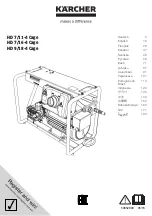
8.2
Safety regulations for cleaning the machine
All cleaning operations must be performed with the machine
stationary and turned off. When cleaning the machine or its
components, the following precautions must be observed:
Do not clean electrical equipment with water or other fluids. To
remove dust, use a clean brush or dry cloth only. Do not clean
plastic surfaces with alcohol, detergent or solvents. Dispose of
cleaning materials in respect of current legislation. Do not dispose of
the materials used or cleaning residues in the environment. To
clean, use water or compressed air and soft cloths. IMPORTANT -
During cleaning, personnel protection devices must be worn
8.3
Safety regulations for repairs and
extraordinary maintenance
For all operations over and above normal routine maintenance,
contact an authorised repair workshop.
All operations must be performed by qualified
personnel with the necessary technical skills to
perform the operations in the maximum safety and in
respect of current legislation.
It should be noted that the warranty offered by the manufacturer is
invalidated if:
•
The instructions given in the "use and maintenance"
manual are not scrupulously respected,
•
Routine maintenance is not performed as and when
indicated;
•
Lubricants other than those specified are used;
•
Repairs or maintenance are performed by unqualified
personnel;
•
Non-original spare parts are used;
•
Unsuitable tools are used.
IMPORTANT - The customer is responsible for
verifying that original parts only are used when
carrying out repairs. The use of non-original spare
parts could jeopardise the safety of the machine.
When ordering spare parts, specify the model and serial number of
the machine and the reference number of the component in the
spare parts book and quantity.
9
Storing the machine
9.1
Storing the machine
If the machine is not used for long periods, protect exposed parts
(not protected by paint, surface treatment or plastic) with protective
rust prevention oils. If the machine is not to be used for particularly
long periods, you should also clean it thoroughly. After performing
these operations, seal the machine inside an opaque black
multilayer nylon bag together with a suitable drying agent (silica gel).
10
Disposal
10.1
Disposing of the machine
At the end of its working life, the machine must be scrapped and
disposed of by taking it to a local differentiated waste collection
centre in compliance with current legislation which must be followed
scrupulously. Before disposing of the machine, check the machine
rating plate. If it bears the
symbol, this means its disposal is
regulated by EC directive 2002/96 on Waste Electrical and
Electronic Equipment, WAEE. You should therefore seek
information on the local electrical and electronic products collection
system and follow the instructions. Disposing of this product illegally
in the household waste could cause serious damage to the
environment and human health and you may be liable to sanctions
from the local authority.
11
Table of regular maintenance
OPERATION
O
N DE
L
IV
E
RY
A
F
T
E
R
U
S
E
E
ver
y 10 h
o
u
rs
E
ver
y 50 h
o
u
rs
E
ver
y 1
0
0
hou
rs
O
T
H
E
R
Check the functioning of all
controls
X
Check connector gaskets
X
Check oil level in the pump
X
X
12
Troubleshooting
The table below gives the most common problems which may arise
during normal use of the high pressure washer. These problems are
easy to resolve with operations classified as routine maintenance If
the problem is not present in the following table or cannot be
eliminated following the instructions here, contact customer service.
PROBLEM
CAUSE
REMEDY
The machine does not
start up
Electrical power
supply absent or
inadequate
Check the characteristics
of the power line
Electrical
protection tripped
Contact customer service
Motor does not start
but makes a noise
Inadequate voltage
Check the characteristics
of the power line
Inadequate pressure
Nozzle blocked or
distorted
Clean or replace
Valve dirty or worn
Contact customer service
Vibrations and/or
abnormal water
discharge
The pump is
sucking in air
Check water supply
connectors
Air in the hoses
Vent the air by
disconnecting the hose
Pump gaskets
worn
Contact customer service
Suction delivery
valves blocked
Unscrew valve caps,
remove and clean (ideally
contact customer service)
Pump noisy
Bearings worn
Contact customer service
"White" oil
Seepage of water
into the oil
(emulsion)
Have the seal pack
replaced by customer
service
Water leaks
Gaskets and/or
pistons worn
Have the seal pack
replaced by customer
service
The water temperature
does not reach the
required level
No diesel oil is
supplied
Fill the tank
Dirty diesel filter
Clean the diesel oil filter
Broken thermostat
Request the intervention
The heating pipe
coil is clogged with
calcareous
Request the intervention


























